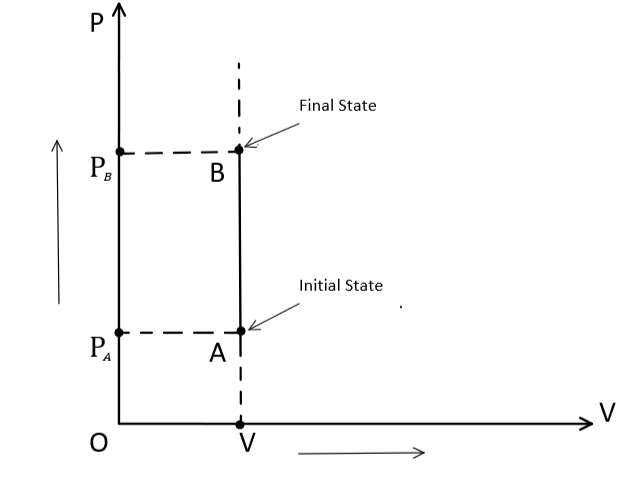
In reversible isochoric change
A. $\Delta W = 0$
B. $\Delta Q = 0$
C. $\Delta T = 0$
D. $\Delta U = 0$
Answer
218.4k+ views
Hint: In this problem, to find out the correct option for a reversible isochoric change; we have to first find out the specific condition for the isochoric process and then analyze that condition with respect to different parameters such as work done, internal energy, temperature, etc., to give a correct result.
Complete answer:
Isochoric process in thermodynamics is a process during which the volume of a system remains constant that’s why it is also referred to as a constant-volume process.
A reversible process in thermodynamics is a process in which both the system and the surroundings return to their original state without any external effect on the universe.
According to the question, An Isochoric change to be reversible, the system must be maintained in thermal equilibrium and heat must be supplied in a quasi-static manner.
Also, we know that Pressure-Volume Work in thermodynamics is defined as: -
At constant pressure, $Workdone = W = P\Delta V$ … (1)
Graphically, an isochoric process can be represented as: -

Also, By definition of an isochoric process, $\Delta V = 0$
So, from eq. (1), we get
$ \Rightarrow W = P\Delta V = 0$
Thus, In a reversible isochoric change $\Delta W = 0$. Hence, the correct option is (A) $\Delta W = 0$
Note: It is crucial to carefully consider all the given possibilities i.e., work done, internal energy, temperature, etc., in order to provide a comprehensive explanation because this is a theoretical conceptual problem. Always keep in mind to give specific justifications with the help of graphs in support of your explanation while writing an answer for this type of conceptual problem.
Complete answer:
Isochoric process in thermodynamics is a process during which the volume of a system remains constant that’s why it is also referred to as a constant-volume process.
A reversible process in thermodynamics is a process in which both the system and the surroundings return to their original state without any external effect on the universe.
According to the question, An Isochoric change to be reversible, the system must be maintained in thermal equilibrium and heat must be supplied in a quasi-static manner.
Also, we know that Pressure-Volume Work in thermodynamics is defined as: -
At constant pressure, $Workdone = W = P\Delta V$ … (1)
Graphically, an isochoric process can be represented as: -

Also, By definition of an isochoric process, $\Delta V = 0$
So, from eq. (1), we get
$ \Rightarrow W = P\Delta V = 0$
Thus, In a reversible isochoric change $\Delta W = 0$. Hence, the correct option is (A) $\Delta W = 0$
Note: It is crucial to carefully consider all the given possibilities i.e., work done, internal energy, temperature, etc., in order to provide a comprehensive explanation because this is a theoretical conceptual problem. Always keep in mind to give specific justifications with the help of graphs in support of your explanation while writing an answer for this type of conceptual problem.
Recently Updated Pages
Two discs which are rotating about their respective class 11 physics JEE_Main

A ladder rests against a frictionless vertical wall class 11 physics JEE_Main

Two simple pendulums of lengths 1 m and 16 m respectively class 11 physics JEE_Main

The slopes of isothermal and adiabatic curves are related class 11 physics JEE_Main

A trolly falling freely on an inclined plane as shown class 11 physics JEE_Main

The masses M1 and M2M2 M1 are released from rest Using class 11 physics JEE_Main

Trending doubts
JEE Main 2026: Application Form Open, Exam Dates, Syllabus, Eligibility & Question Papers

Derivation of Equation of Trajectory Explained for Students

Hybridisation in Chemistry – Concept, Types & Applications

Understanding the Angle of Deviation in a Prism

Understanding Collisions: Types and Examples for Students

Understanding Atomic Structure for Beginners

Other Pages
JEE Advanced Marks vs Ranks 2025: Understanding Category-wise Qualifying Marks and Previous Year Cut-offs

Units And Measurements Class 11 Physics Chapter 1 CBSE Notes - 2025-26

NCERT Solutions For Class 11 Physics Chapter 8 Mechanical Properties Of Solids

Motion in a Straight Line Class 11 Physics Chapter 2 CBSE Notes - 2025-26

NCERT Solutions for Class 11 Physics Chapter 7 Gravitation 2025-26

How to Convert a Galvanometer into an Ammeter or Voltmeter




